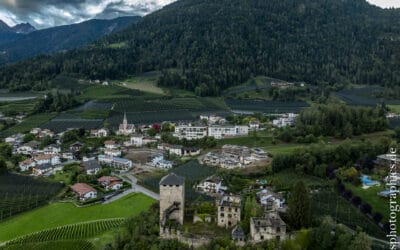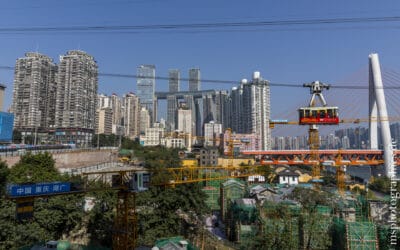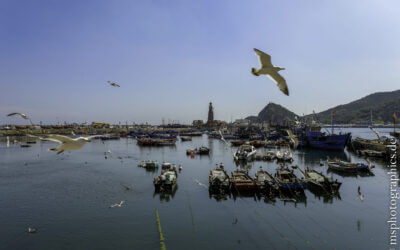Zhangjiajie and Fenghuang - Travel Planning:
For the trip to Zhangjiajie and Fenghuang from the Beijing I have planned one week. You can easily get to Zhangjiajie by plane. A direct flight takes about three hours, but there is usually a short stopover in the provincial capital of Hunan, Changcha, neccessary. It then takes about 4.5 hours to get there.
Zhangjiajie Airport is just outside the city and it takes about 20 minutes to get to the accomodation by taxi.
The best months for good weather in Zhangjiajie are March and October. June, July and August are the warmest months on average. January is the coldest. The rainy season is in June and July.
I visited the region from late May to early June and also experienced heavy rain. Nevertheless, in my opinion, Zhangjiajie is particularly fascinating, especially under rainy conditions.
Especially in the rainy season, the paths in the national park are sometimes very slippery. Sturdy shoes are essential.
Accommodation in Zhangjiajie:
The first night I spent in the Zhangjiajie Yijiaqin Hotel that is ideal to visit the Tianmen Mountain in the close neighborhood. It is located about 800 meters from the ground station of the gondola lift.
The bus station for trips to Fenghuang is also close to the gondola and can also be easily reached on foot from the hotel.
After arriving at the hotel and having lunch, the plan was to take the gondola up to Tianmen Mountain in the afternoon. The gondola lift with 98 gondolas, a total length of 7455 m and a height difference of 1279 m is the longest passenger railway in the world.
The Tianmen Mountain:
The mountain is known because of the imposing Tianmen Cave, the natural hole in the mountain known as the "Heavenly Gate" with a height of 131.5 meters. This hole in the mountain has already been used for various events in the area of base jumping and parachuting.
The stairs with 999 steps down to the parking lot are no less impressive. These stairs are also used regularly for events such as a parcours competition.
The street down into town is also something special. With its 99 curves, mountain races have also been held here. Taking one of the buses down into the valley is a very special experience.
Once on the high plateau of the Tianmen Mountain, you can go on some spectacular hikes.
Narrow paths lead along the rock face, some with glass floors, which open up spectacular views of the landscape and the valley.
The road of 99 curves:
Directly below, the road with its 99 curves winds from the parking lot below the sky gate down into the city of Zhangjiajie.
The drive with one of the buses over the distance of almost 11 kilometers seems like an estimated eternity.
Especially in oncoming traffic situations, this is not for weak nerves or people with a queasy stomach.
The hike:
On the high plateau of Tianmen Mountain itself, you can spend several days on the kilometers of hiking trails.
In one afternoon you can discover the most interesting attractions, such as glass bridges or high-altitude trails, and hike down through the Heavenly Gate and via the stairs with its 999 steps back into the valley.
The way over the glass bridges is an extremely unfamiliar undertaking on the first try and it takes a few steps to get used to it.
The hike on the high plateau of the Tianmen Mountain offers all kinds of variety and impressive views of the fascinating carst mountains landscape. Escalators inside the mountain lead down to the Heavenly Gate above the 999-step staircase.
An imposing sight, the 131.5 meter high hole in the mountain and the 999-step staircase in the foreground, where the obstacle course from the competition the day before is still set up.
The drive from Zhangjiajie to Fenghuang:
From Zhangjiajie you can take a trip to the old town of Fenghuang. This requires two nights in Fenghuang. From the bus station near the gondola, you can get inexpensive to Fenghuang. A stay of several hours in the old town of Furong is planned on the way.
Stopover in Furong:
Furong war ursprünglich als Wangcun bekannt, wurde aber nach dem Erfolg des gleichnamigen Films „Hibiscus Town“ umbenannt. Die Stadt liegt etwa auf halbem Weg zwischen Zhangjiajie und Fenghuang und ist auf Grund der alten Gebäude, zwischen denen sich der Fluss You seinen Weg bahnt, ein lohender Abstecher.
Old, wood-clad houses in the typical old Chinese architectural style characterize the cityscape along the river. Most of the houses are decorated with numerous red lanterns.
Cross a stone palisade bridge over the river and down to the waterfall, the highlight of Furong.
From one of the numerous cafes and restaurants along the river bank you have a wonderful view over the old town and the waterfall before you return to the bus and continue your trip to Fenghuang.
Fenghuang Old Town:
Many of the old houses offer accommodation on the upper floors with balconies and views of the river. I booked for staying in Fenghuang the Beiyimen Riverside Boutique Guesthouse for two nights.
The rooms are simply but comfortably furnished and there is a small balcony with a hanging chair and a view of the river. Breakfast is not included in the accommodation.
The wooden boats line up in front of the old houses on the river and wait for guests who want to see the old town from the water. This is a good possibility to avoid the hustle and bustle on the footpaths.
Due to the rainy season, the water was very churned and colored sandy-brown. The water was just below the house entrances.
In the afternoon the next dark clouds appeared and announced the next thunderstorms.
Nevertheless, there is always enough time to try on traditional clothing of the minorities living there and to take souvenir photos against the backdrop of the city.
Over the old city wall, outside the historic old town center, you can go up to a hill, from which you have a wonderful view over the roofs of Fenghuang.
In the middle of the woods, umbrellas decorate a forest clearing. During the rainy season they would most likely be used in the city as well.
The nightlife in Fenghuang:
Fenghuang becomes particularly fascinating and interesting after dark, when the entire old town is illuminated and comes alive with night life.
The nights here are not historic and quiet. Numerous bars on the ground floors of the houses along the river really heat up visitors with music and dancing until shortly before midnight.
In addition to partying and dancing, Fenghuang offers night boat trips and impressive illuminated buildings. An evening tour of the city is at least as fascinating as it is during the day.
After two nights in Fenghuang, we went back towards Zhangjiajie, where a visit to the Zhangjiajie Wulingyuan National Park was planned for the next few days. The landscape there served as the backdrop for the movie classic Avatar – Departure for Pandora.
Arrival back in Zhangjiajie:
For visiting the national park it was planned to stay in one of the accommodations in the park. At the entrance, however, I learned that these were closed at short notice for nature conservation reasons.
Instead I booked the Qifengling Hostel which is only a few minutes' walk from the park entrance.
The Zhangjiajie Wulingyuan National Park:
For visiting the Zhangjiajie Wulingyuan National Park, which has been a UNESCO cultural heritage since 1992, at least two days are required, and you can easily spend more time there.
In general, it is worthwhile to be at the park early and to try to get tickets, because the rush is already large early in the morning. In the park itself, the visitors are well distributed and you don't have the feeling that it is overcrowded.
From the park entrance either shuttle buses or a cable car bring you in the direction of the viewpoints that are well worth seeing. From the gondola you can already guess what a spectacular landscape awaits you here.
Hiking in Zhangjiajie Wulingyuan National Park:
Behind the mountain station, the hike begins on the high plateau with numerous vantage points from which you can overlook the landscape with its imposing karst pillars.
It is absolutely impressive in what inhospitable areas plants settle and provide food for all kinds of living species.
The landscape of the Zangjiajie Wulingyuan National Park looks majestic and surreal at the same time. The perfect location for a blockbuster movie.
The more clouds come up and the darker the mood becomes, the more you feel like you are part of the movie, while the mountain peaks seem to float above the clouds.
To see the effect of the landscape in the middle of the clouds was much more impressive for me as when the weather would have been nice. Therefore, from my point of view, it is difficult to give a recommendation for the best travel time. That depends a lot on personal preferences.
The Bailong Elevator, along one of the karst walls, with 376 meters of hight, is the highest and heaviest outdoor elevator in the world. It has even been in the Guinness Book of Records since 2015.
In the national park you can occasionally come across monkeys living in the wild. Because of their curiosity, important items should always be safely stowed away.
A curious but peaceful contemporary of the monkey rascals took time for a nice portrait photo and looked friendly into the camera.
The impressions gained in the rain will definitely remain positive in my mind. The landscape appears particularly fresh when it rains and there are significantly fewer visitors to the park.
The sometimes narrow and steep paths through the national park become a slippery undertaking when wet. Steady footing and sturdy shoes are essential here.
Even unusual smaller climbs over ladders and suspension bridges can be discovered in the park. The ladders lead to very special vantage points with a unique panorama.
After two days, mostly on foot on the kilometer-long hiking trails in the park and countless impressions, we took the bus back down to the exit.
The Zhangjiajie Wulingyuan National Park is definitely worth a visit and is impressive in different ways any time of the year.
The Zhangjiajie Wulingyuan Baofeng Lake:
Baofeng Lake was artificially created in the 1970s. It is a fresh water lake with an average depth of 72 meters and a length of about 2.5 kilometers.
The Zhangjiajie Grand Canyon Glass Bridge:
The bridge is approved for 800 people at the same time, which corresponds to a capacity of 8,000 visitors. Shortly after it opened, the bridge even had to be closed again for a short time due to the huge amount of visitors.
Crossing the bridge is an experience not to be missed when visiting the region.
Conclusion:
The journey from Beijing to Zhangjiajie and Fenghuang with a visit to the old town of Furong was marked by intense impressions, adventures and fascinating memories.
The alternation between visiting historical cities and hiking in unique nature was the perfect mix for an eventful week.
With a lot of delay due to the bad weather, we went back to the capital Beijing late in the evening. Flight delays during the rainy season are not uncommon and should definitely be taken into account.































































0 Comments